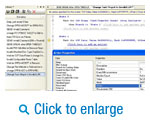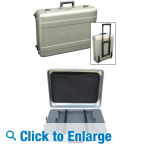Sierra Error Injector (Jammer)
Building on the capabilities of the industry's first SAS/SATA error injection system, the InFusion option for Sierra M124A/M122A can programmatically alter or corrupt traffic for both SAS 12G and SATA 6G protocols. Fully integrated within the Sierra platform, Infusion is designed to create faulty link conditions while the analyzer records the real response from the system under test. The InFusion 12G solution is the ideal tool for stress testing systems while running real traffic and actual workloads.

Impair and Analyze up to 4-wide Links Simultaneously
The Sierra InFusion 12G system on the M124A platform can operate on up to four SAS or SATA links simultaneously (on the M122A platform, up to 2 links are supported). The Sierra analyzer can simultaneously monitor traffic in both directions over the same physical links. By default, the analyzer will use two channels to monitor before and after the error injection.
Powerful Error Injection and Traffic Modification Abilities
Once the Sierra InFusion system has been added to a SAS or SATA link, it automatically passes the boot up sequence and preserves protocol handshaking between devices. It silently monitors the line while transmitting a faithful copy of the original data stream. The system will wait for a specific time interval or count a particular event that you designate before it begins modifying frames or injecting errors. Sierra InFusion can be configured to send a single error, multiple errors, or random errors.
When changing fields within a frame, the Sierra InFusion traffic modifier will preserve the outbound frame structure, including recalculating the CRC if needed. The response transmitted from the device-under-test will pass through the Sierra system, without modification. This allows true end-to-end system testing. The Sierra InFusion software will maintain a log that contains a summary of the exchange.
Versatile and Easy to Use
In just minutes, an easy-to-use pop up menu interface makes it easy to create test scenarios. Any primitive or data pattern can be intercepted and changed to a user defined pattern. From dropping entire packets - to changing any field within a frame, the Infusion system can create data integrity or simple handshaking errors. This allows for unprecedented corner case and protocol level stress testing for SAS and SATA traffic.
The Sierra InFusion 12G software was designed to modify existing traffic between an initiator and a target, which better reflects real world operating conditions compared to script based simulations. Test scenarios are independent of hardware setup and rarely need to be tuned for different configurations. Saved test scenarios can be recalled making it easy to re-verify system behavior during regression testing of software or firmware.
Sophisticated error injection strategies are now possible using the dual sequencers with up to 256 sequential wait states per sequence. Each state can be configured to check for different conditions or inject different errors before branching to the next state. Looping allows the error injection sequence to repeat at specific intervals. Each sequential state can also include timers and counters to better isolate specific link conditions.
A Comprehensive Solution for SAS and SATA
Teledyne LeCroy's SAS and SATA solutions provide you with advanced features necessary to ease the development and deployment of SAS and SATA devices. By combining the functionality and power of a Sierra SAS/SATA Analysis, Traffic Generator, and InFusion Error Injector, you have a complete system that gives you the most in-depth analysis, testing, and validation available for SAS and SATA.
Sierra SAS Traffic Generator
The Sierra M124A 12G SAS Traffic Generator is a script-based traffic generator that gives engineers the ability to control what is being sent down to the bit level, including flexibility for changing OOB waveforms, defining IDLE traffic, and transmitting user-defined data patterns for customized testing throughout the design process.
Using previously recorded SAS traffic files (.SAS) it’s possible to export either host or device side transmissions to the generator file format. This allows validation engineers to easily recreate problems reported in the field using a trace file. Any sequence of SAS or SATA packets captured with the Sierra analyzer can be edited and then played back as a test pattern using the Sierra traffic generator.
Sierra also offers a text-based API for creating scripts from the ground up. This mode is ideal for performing corner-case, stress and limit testing. It can also be used to validate protocol compliance and fault handling by injecting code violations, CRC, scrambling and protocol errors, or customized data payloads.
SAS and SATA "handshaking" are global settings that allow the Sierra to automatically reply to out-of-band and speed negotiation signals. When enabled in a script, they allow the Sierra to independently respond to events like open requests, and acknowledge frames. The Traffic Generator supports unlimited levels of IF-THEN-ELSE logic which can be added to a script and allow the exerciser to conditionally respond to inbound frames or data patterns. This expands the range of tests that can be completed with Sierra by enabling longer exchanges with larger test configurations.
SAS 6 Gbps Analysis Option
The Sierra M124A platform is available in SAS 6Gbps configurations for developers not yet ready to move to 12Gbps. This allows customers to invest in the flagship Sierra platform and easily upgrade via software license key to support 12Gbps in the future. All the same options are available in the SAS 6Gbps configurations including memory, traffic generation and Infusion capabilities. To order the 6Gbps Analysis option for the Sierra M122A/M124A base platform, use the items below:
SAS-T612-002-X Sierra M124A or M122A SAS 2.0 (6G) Protocol Analysis & Cable bundle - Analysis License for 1st and 2nd port (Includes one (1) Ext. MiniSAS HD to 6G External MiniSAS cable, 1m; and one (1) Ext. MiniSAS HD to 7Pin SATA cable, 1m)
SAS-T612-004-A Sierra M124A or M122A SAS 2.0 (6G) Protocol Analysis - License for 3rd & 4th ports (License key enables analysis of ports 3 and 4 for 3G/6G only)
CrossSync Multi-Protocol Analysis option
CrossSync is Teledyne LeCroy's analyzer synchronization solution that enables time-aligned display of protocol traffic from multiple daisy-chained analyzers. Captured packets are displayed in separate windows that share a common time scale. Navigating the traffic in either direction will scroll to the same timestamp in the synchronized window. When using the CrossSync option, users can access the full complement of analysis capabilities available within each individual Teledyne LeCroy software. Search, reporting, and decoding all operate normally.

Identifying the point where a specific bus event moves over a bridge is nearly impossible without the CrossSync synchronization solution. Now it's easy to use triggering to find the same packet travelling across both busses. Either analyzer can be set up as the trigger master. When the trigger event is detected, the capture on all daisy chained analyzers stops, Each display will show the exact point where the event occurred. It's also possible to define separate trigger events that operate independently for each side of the bridge.
The solution includes a lightweight software control panel that starts and stops recording across daisy-chained analyzers. Users can sync or un-synch traces on-the-fly. The Time Tune feature provides a real time slider for adjusting the offset between displays. This makes it easy to see latency across busses.

The CrossSync control panel is available at no cost and only requires the analyzers to be connected using their on-board Sync ports. This Sync port is built-in to every Advisor T3 and STX M6-1 analyzer. For owners of Teledyne LeCroy's, Summit T3, Voyager M3i, and Sierra -based analyzers, the Sync port is available as an optional expansion board (ACC-EXP-002-X) that can be installed by users in just a few minutes. This allows developers to leverage analyzers already in the lab to help resolve multi-protocol problems at the system level.

The CrossSync option supports a wide combination of Teledyne LeCroy's flagship analyzers including PCI Express Gen 1, Gen 2 and Gen 3, USB 2.0 and 3.0, Serial ATA (SATA) 1.5, 3, and 6Gbps, Serial Attached SCSI 6Gbps, and Fibre Channel 1, 2, 4 and 8Gbps systems.
Sierra External Power Expansion Card v2

The Sierra External Power Expansion Card v2 combines configurable AC power supply for the DUT with the CATC Sync port. Specifically designed for powering SAS/SATA HDD/SSDs during Sierra Emulator or Trainer test sessions, the Power Expansion card can also be used in analyzer mode to graphically display power consumption used by the device. Special support for SATA DevSleep allows real time verification of low power behaviors, by allowing control and monitoring of the DevSleep signal. The card is easily installed by the user and is compatible with the Sierra M6-2, M6-4, M124A, and M122A.

Power Expansion card (model: ACC-EXP-005-X) includes custom cables below:
- 15 pin Sata Power Cable
- 4 pin Sata Power Cable
- Analyzer mode SATA DevSlp Cable, which includes :
- 1 DevSlp wire to solder or clip to the DevSlp pin of the Host or DUT
- 1 Gnd wire to solder or clip to the Gnd pin of the Host or DUT
- Solder tips and Gripper Clips

SAS Verification Option
The SAS Verification option (6G & 12G) for the Sierra platform helps storage integrators test and qualify SAS HDD and SSD devices for conformance to the SAS specifications. The suite includes over 60 separate test cases covering dozens of PHY, Link and Transport layer assertions. For storage integrators, the SAS Verification option has become an indispensable tool for screening HDD and SSD devices to verify they properly implement speed negotiation and link layer recovery behaviors.
 Fully automated, SAS Verification loads individual test scripts that generate specific traffic conditions to test individual SAS protocol rules. The responses from the DUT are automatically captured and analyzed for correct behavior. A pass/fail report is generated in text or HTML. Upon starting the test suite, SAS Verification automatically queries the DUT to determine the SAS Address which is re-used throughout the test run. The entire process is automated through a single easy-to-use application which allows users to run individual tests or the entire suite in a single pass. Traces are saved and violations reported for any fail cases. SAS Verification provides full source code for the test scripts (initiator) allowing developers to adapt this substantial library for their own custom test cases.
Fully automated, SAS Verification loads individual test scripts that generate specific traffic conditions to test individual SAS protocol rules. The responses from the DUT are automatically captured and analyzed for correct behavior. A pass/fail report is generated in text or HTML. Upon starting the test suite, SAS Verification automatically queries the DUT to determine the SAS Address which is re-used throughout the test run. The entire process is automated through a single easy-to-use application which allows users to run individual tests or the entire suite in a single pass. Traces are saved and violations reported for any fail cases. SAS Verification provides full source code for the test scripts (initiator) allowing developers to adapt this substantial library for their own custom test cases.

The SAS Verification option for 6G/12G runs on the M124A/M122A platform. There is a 6G only version available for the M6 family of SAS analyzers. The package also requires the Power Expansion card is installed in the Sierra platform which automatically cycles power between tests. Use the models below to order the SAS Verification option.
Part #: SAS-VS-12-S02-A Sierra SAS 6G/12G Verification Suite M124A/M122A
Part #: SAS-VS-06-S02-A Sierra SAS 6G Verification Suite M6-4 / M6-2
Part #: ACC-EXP-005-X Sierra External Power Expansion Card v2
1U Zero Carrying Case

- Brushed Aluminum Exterior
- Multi-position telescoping handles adapts for easier handling
- Fully-lined foam interior designed to protect equipment
- Mesh pocket for accessories & cables
- Part number: AC021XXA-X